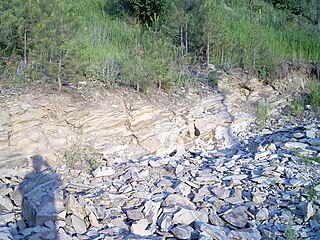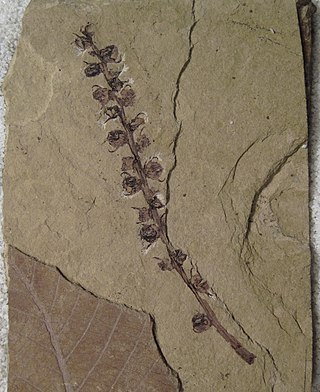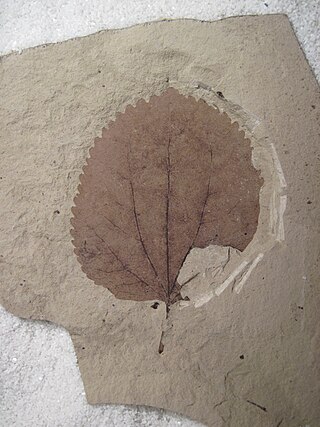
Trochodendron is a genus of flowering plants with one living species, Trochodendron aralioides, and six extinct species known from the fossil record. It was often considered the sole genus in the family Trochodendraceae, though botanists now also include the distinct genus Tetracentron in the family.

Trochodendraceae is the only family of flowering plants in the order Trochodendrales. It comprises two extant genera, each with a single species along with up to five additional extinct genera and a number of extinct species. The living species are native to south east Asia. The two living species both have secondary xylem without vessel elements, which is quite rare in angiosperms. As the vessel-free wood suggests primitiveness, these two species have attracted much taxonomic attention.
Trochodendron drachukii is an extinct species of flowering plants in the family Trochodendraceae known from a fossil fruiting structure found in the early Ypresian age Eocene fossils found in British Columbia, Canada. T. drachukii is one of the oldest members of the genus Trochodendron, which includes the living species T. aralioides, native to Japan, southern Korea and Taiwan and the coeval extinct species T. nastae from Washington state, United States.

The Klondike Mountain Formation is an Early Eocene (Ypresian) geological formation located in the northeast central area of Washington state. The formation is comprised of volcanic rocks in the upper unit and volcanic plus lacustrine (lakebed) sedimentation in the lower unit. the formation is named for the type location designated in 1962, Klondike Mountain northeast of Republic, Washington. The formation is a lagerstätte with exceptionally well-preserved plant and insect fossils has been found, along with fossil epithermal hot springs.
Acer browni is an extinct maple species in the family Sapindaceae described from a series of isolated fossil leaves and samaras. The species is known from the early to middle Miocene sediments exposed in Western Oregon, Washington state, USA and Northern Graham Island, Haida Gwaii, Canada. It is one of several extinct species placed in the living section Parviflora.
Acer clarnoense is an extinct maple species in the family Sapindaceae described from a series of isolated fossil leaves and samaras. The species is known from the late Eocene sediments exposed in the state of Oregon in the US. It is one of several extinct species placed in the living section Macrantha.

The McAbee Fossil Beds is a Heritage Site that protects an Eocene Epoch fossil locality east of Cache Creek, British Columbia, Canada, just north of and visible from Provincial Highway 97 / the Trans-Canada Highway. The McAbee Fossil Beds, comprising 548.23 hectares, were officially designated a Provincial Heritage Site under British Columbia's Heritage Conservation Act on July 19, 2012. The site is part of an old lake bed which was deposited about 52 million years ago and is internationally recognised for the diversity of plant, insect, and fish fossils found there. Similar fossil beds in Eocene lake sediments, also known for their well preserved plant, insect and fish fossils, are found at Driftwood Canyon Provincial Park near Smithers in northern British Columbia, on the Horsefly River near Quesnel in central British Columbia, and at Republic in Washington, United States. The Princeton Chert fossil beds in southern British Columbia are also Eocene, but primarily preserve an aquatic plant community. A 2016 review of the early Eocene fossil sites from the interior of British Columbia discusses the history of paleobotanical research at McAbee, the Princeton Chert, Driftwood Canyon, and related Eocene fossil sites such as at Republic.
Acer palaeorufinerve is an extinct maple species in the family Sapindaceae described from series of isolated fossil samaras and leaves. The species was described from Miocene to Pliocene aged fossils found in Japan and is known from Korean fossils and Miocene sediments exposed in the state of Alaska, USA. It is one of several extinct species placed in the living section Macrantha.
Acer traini is an extinct maple species in the family Sapindaceae described from isolated fossil samaras. The species was described from Miocene-aged fossils found in Canada and the United States of America. It is one of several extinct species placed in the living section Glabra.

Acer chaneyi is an extinct maple species in the family Sapindaceae described from a number of fossil leaves and samaras. The species is known from Oligocene to Miocene sediments exposed in Alaska, Idaho, Nevada, Oregon and Washington in the U.S. It is one of several extinct species belonging to the living section Rubra.
Acer taggarti is an extinct maple species in the family Sapindaceae described from a number of fossil leaves and samaras. The species is known from Miocene sediments exposed in central Oregon, US. It is one of several extinct species belonging to the living section Rubra.

Shirleya is an extinct genus in the crape myrtle family, Lythraceae, which contains a single species, Shirleya grahamae. The genus and species are known from Middle Miocene fossils found in Central Washington.

Pentacentron is an extinct genus of flowering plant in the family Trochodendraceae, consisting of the single species Pentacentron sternhartae. The genus is known from fossil fruits found in the early Eocene deposits of northern Washington state, United States. P. sternhartae are possibly the fruits belonging to the extinct trochodendraceous leaves Tetracentron hopkinsii.

Tetracentron hopkinsii is an extinct species of flowering plant in the family Trochodendraceae. The species is known from fossil leaves found in the early Eocene deposits of northern Washington state, United States and south Central British Columbia. The species was first described from fossil leaves found in the Allenby Formation. T. hopkinsii are possibly the leaves belonging to the extinct trochodendraceous fruits Pentacentron sternhartae.
Trochodendron postnastae is an extinct species of flowering plant in the family Trochodendraceae. The species is known from fossils found in Middle Miocene deposits of central Oregon. T. postnastae are possibly the leaves belonging to the extinct trochodendraceous fruits Trochodendron rosayi.
Acer cascadense is an extinct maple species in the family Sapindaceae described from a series of isolated fossil samaras. The species is known from fossils found in Middle Miocene deposits of central Oregon. It is one of several extinct species placed in the living Acer section Negundo.
Trochodendron rosayi is an extinct species of flowering plant in the family Trochodendraceae. The species is known from fossils found in Middle Miocene deposits of central Oregon. T. rosayi are possibly the fruits belonging to the extinct trochodendraceous leaf species Trochodendron postnastae.
Paraconcavistylon is an extinct genus of flowering plant in the family Trochodendraceae comprises a single species, Paraconcavistylon wehrii. The genus is known from fossil fruits and leaves found in the early Eocene deposits of northern Washington state, United States, and southern British Columbia, Canada. The species was initially described as a member of the related extinct genus Concavistylon as "Concavistylon" wehrii, but subsequently moved to the new genus Paraconcavistylon in 2020 after additional study.
The paleoflora of the Eocene Okanagan Highlands includes all plant and fungi fossils preserved in the Eocene Okanagan Highlands Lagerstätten. The highlands are a series of Early Eocene geological formations which span an 1,000 km (620 mi) transect of British Columbia, Canada and Washington state, United States and are known for the diverse and detailed plant fossils which represent an upland temperate ecosystem immediately after the Paleocene-Eocene thermal maximum, and before the increased cooling of the middle and late Eocene to Oligocene. The fossiliferous deposits of the region were noted as early as 1873, with small amounts of systematic work happening in the 1880-90s on British Columbian sites, and 1920-30s for Washington sites. A returned focus and more detailed descriptive work on the Okanagan Highlands sites revived in the 1970's. The noted richness of agricultural plant families in Republic and Princeton floras resulted in the term "Eocene orchards" being used for the paleofloras.

Pteronepelys, sometimes known as the winged stranger, is an extinct genus of flowering plant of uncertain affinities, which contains the one species, Pteronepelys wehrii. It is known from isolated fossil seeds found in middle Eocene sediments exposed in north central Oregon and Ypresian-age fossils found in Washington, US.







